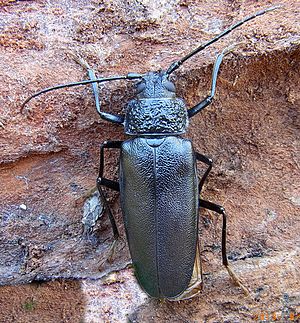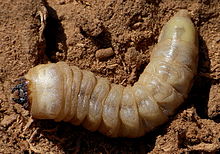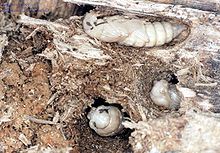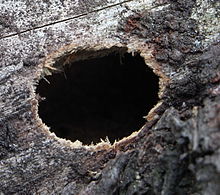Mulmbock
| Mulmbock | ||||||||||||
|---|---|---|---|---|---|---|---|---|---|---|---|---|

Mulmbock, female |
||||||||||||
| Systematics | ||||||||||||
|
||||||||||||
| Scientific name | ||||||||||||
| Ergates faber | ||||||||||||
| ( Linnaeus , 1761) |
The Mulmbock or rooms Bock ( Ergates faber ) is a beetle of the family of longhorn beetles (Cerambycidae) and belongs to the subfamily Prioninae . It is one of the largest indigenous longhorn beetles in Central Europe .
description
The Mulmbock is between 27 and 60 millimeters in size. It's flat. Its pronotum is twice as wide as it is long and serrated on the sides. The sexes differ in color (the males are russet and the females pitch brown) and the length of the antennae . The antennae of the male animals are a little longer than body length, in the female they reach about to the middle of the elytra . While the pronotum of the female is heavily wrinkled, that of the male has two smooth bumps.
Way of life
The beetles fly around noon. Your flight time is from mid-July to mid-September. The females lay up to a total of 275 eggs in smaller piles of eight to ten (but also up to 60) pieces of dead coniferous wood . Tree stumps on sunny stand edges or on clear-cuts are preferred.
At lower and medium altitudes, it is mainly pine that is attacked, in the Alps at altitudes above 1000 m it is often also spruce or occasionally fir or larch . HELLRIGL also reports individual observations on hardwoods such as alder and poplar . Infestation in injured parts of living trees is also possible in individual cases.
The larvae hatch after 2 to 3 weeks in order to dig into the wood. Their development takes 3 to 4 years. During this time they reach a length of 60–65 (sometimes up to 80) mm. They have strong mandibles and clearly developed creeping bulges on abdominal segments 1–7, with which they can move unusually fast for longhorn beetle larvae. Although there are legs, they are relatively small. The larvae need wood moisture for good development, which is why both the underground and above-ground parts of the trunk are preferred. In the case of the heartwoods pine and larch, only the sapwood is usually destroyed, whereas in the case of spruce and fir, the entire wood body is destroyed. Here the wood is transformed into mulm (hence the German name). This consists of wood chips and feces. The surface of the wooden body is left intact. The larva usually pupates in the wood near the surface, even if there are individual finds of pupae in burrows near the infected wood. To hatch, the beetle gnaws an oval entrance hole with frayed edges into the surface of the wooden body.
As part of the chain of decomposition in wood, the Mulmbock is an important part of the ecological cycle . But like other xylophage insects, it occasionally attacks processed wood. Fence posts and masts made of pine wood are particularly popular in the earth-air area. In the past, damage to telephone poles, which at that time was still protected with a Carbolineum paint, was mentioned several times in the literature . This could not prevent the infestation, on the contrary it even had an attractive effect on the beetles.
The Mulmbock is rare in Germany and is affected by the decline in many areas. It does not occur in Baden or Saarland . No more finds were reported in Württemberg or North Rhine-Westphalia after 1950. Finds from North Rhine and Schleswig-Holstein are traced back to import or dragging.
Individual evidence
- ↑ Klaus G. Hellrigl: "On the question of breeding plants and the physiological harmfulness of native prions (Col., Ceramb.) " Anzeiger für Schädlingskunde und Pflanzenschutz, Issue 12, 1971.
- ^ F. Köhler, B. Klausnitzer (Ed.): Entomofauna Germanica, Directory of Beetles in Germany , Dresden 1998, ISSN 0232-5535 .
literature
- Adolf Brauns: Pocket book of forest insects . 4th edition, Gustav Fischer Verlag 1991, pp. 240–241, ISBN 3-437-30613-8
- Karl Wilhelm Harde, Frantisek Severa and Edwin Möhn: The Kosmos Käferführer: The Central European Beetles. Franckh-Kosmos Verlags-GmbH & Co KG, Stuttgart 2000, ISBN 3-440-06959-1 .
- K. Escherich: The forest insects of Central Europe, second volume , Berlin 1923
- Wolfgang Schwenke (Hrsg.) Among others: The forest pests of Europe. A manual in 5 volumes - Volume 2: Beetles . Parey, Hamburg and Berlin 1974, pp. 149-150, ISBN 3-490-11216-4



